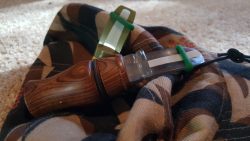Off-the-shelf calls may not sound like an elk and there are reasons for that.
Some of the reasons are within your control and some aren’t. Here’s what makes a call sound good and a few tips to make them great.
Reed Call Parts and Function:

Tone Board: The shape of the tone board’s tip can effect whether the reed will freeze down during cold weather or keep functioning until the moment of truth. It should taper down and away from the reed but not so much that the reed can bend and form a crease. The channel in the sound board should create a back-pressure effect like a trumpet.
Reed: Thin reeds down to .01” thick are sensitive and easier to blow but have a quiet, short range projection. Blowing too hard on thin reeds can result in the reed shrieking to a stop mid-call. That’s bad. Thicker reeds between .015 – .0175 can be blown harder giving the caller the ability to produce a loud long range call. As a general rule, narrow reeds create high pitched sounds and wide reeds yield much deeper sounds. Reed replacements are cheap and can be sanded and trimmed to produce the perfect sound.
Keeper: The keeper simply holds the reed in place at the bottom of the tone board. It’s not critical for sound but can impact the ease of reed replacement.
Barrel: The barrel can be as simple as a two inch hollow piece of wood or a complex ribbed tube with a horn shape designed to resonate and create back pressure. Changing the barrel by adding a flexible tube or blowing into a horn can drastically change the quality of the sound and projection of the call. The easiest way to affix a new make-shift tube or barrel is with duct tape and super glue. It might be ugly but it can help make a good call great.
Rubber Band: Moving the rubber band (or adding one) alters the reeds fulcrum point. This alteration will affect the length and pitch of the calls you make and can serve as a stopping point for consistency. Callers may mark two or three points along the tone board and adjust the rubber band position over the mark for short chirps or long estrus moans.
Sound: The product of a well tuned and tested call. If it doesn’t sound like an elk, change it.
Knowing the anatomy of your elk call can help you tune the sound until it can convince a bull that you’re a real elk. Your next punched tag all starts with understanding how your call works. Good Luck!